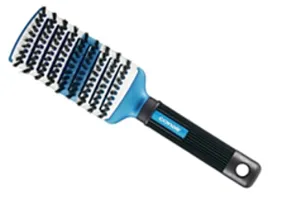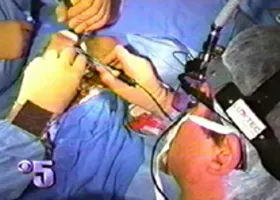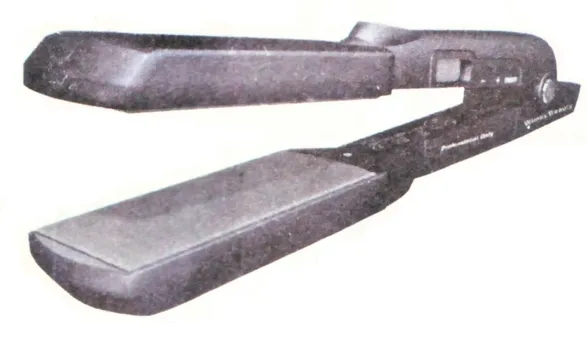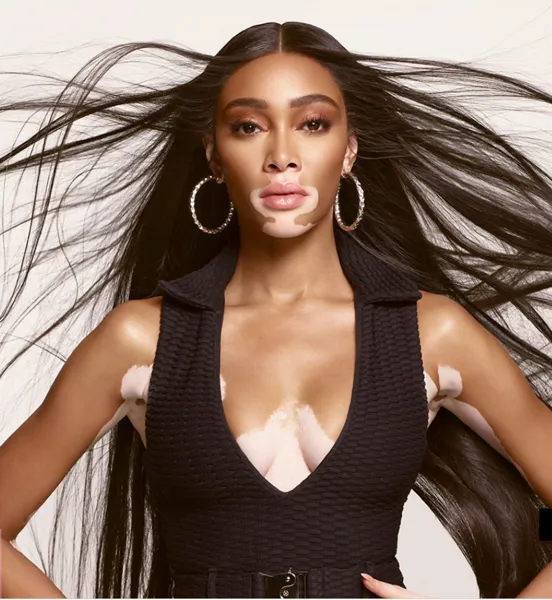
Caring For Curly Hair: Brushing Secrets
 If you have natural texture, whether it's waves, curls, coils or a combination at some point you've probably had to deal with clumps, snarls or pockets of frazzled frizz.
If you have natural texture, whether it's waves, curls, coils or a combination at some point you've probably had to deal with clumps, snarls or pockets of frazzled frizz.
You've also probably had to evaluate your entire hair care, styling tools and routines. One persistent question is whether to brush or not to brush your naturally textured hair. Even more importantly, if you shouldn't brush your hair when wet, what about when dry?
(Image of Alex Kingston - DC Media - All Rights Reserved)
Never Brush Hair When Wet
The prevailing natural texture wisdom is to never brush natural texture when it's wet or damp. Of course this theory is considered true across the board for all types of texture because hair is so much more fragile when it's wet and can rip, stretch and pull more easily.
Brushing wet curls, kinks and coils is considered even more harmful because the brushing can potentially disrupt your natural curl pattern. Since the whole goal of going natural with curls is to encourage the natural clumping and coiling, brushing when wet basically throws this goal to the wind.
Other side effects of brushing wet curls includes the promotion of frizz, damaged cuticles and pulling the hair causing stress and ongoing breakage.
Avoid Brush Temptations
 It may be tempting for some naturally textured people with super thick curls to be tempted to brush their tresses, especially when loaded down with rinse-out conditioner and water. Is this damaging the hair? In all likelihood yes, but of course you know my theory about hair care which is always honor what works best for you.
It may be tempting for some naturally textured people with super thick curls to be tempted to brush their tresses, especially when loaded down with rinse-out conditioner and water. Is this damaging the hair? In all likelihood yes, but of course you know my theory about hair care which is always honor what works best for you.
The common recommendation for detangling curls, waves, kinks and related texture is to do it in the shower while hair is wet and full of rinse out conditioner before the final cool/cold water rinse.
Although wide tooth combs are acceptable, and can be used on just about any type of textured tresses, the best approach for healthy and safe detangling is with the fingers.
Yes, sometimes the challenge is that hair is so thick and so curly it's hard to get through with just the fingers. Should you use a brush? Of course this is a question you should cover with your own personal curl expert, but generally speaking the answer is no.
If fingers or detangling comb don't work a good compromise might be a wide tooth pick with smooth teeth. If that compromise works for you, start at the ends and very slowly work up towards the roots. And yes, condition laden wet strands are the best to safely detangle with a pick.
Brushing Dry Hair?
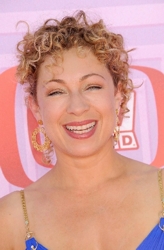 Any kind of brushing is considered harmful to curly hair because the very act results in some form of frizz from minor to major. This means brushing textured hair when it's dry can potentially be just as problematical as when it's wet. This is especially true when the hair has been previously treated with chemicals such as hair color, relaxers or straighteners.
Any kind of brushing is considered harmful to curly hair because the very act results in some form of frizz from minor to major. This means brushing textured hair when it's dry can potentially be just as problematical as when it's wet. This is especially true when the hair has been previously treated with chemicals such as hair color, relaxers or straighteners.
My own hair is a combination of naturally wavy and curly. My curls are embedded through out the nape of my neck where it's hard to reach. Although I follow the no brush rule for detangling my waves and curls, using on my fingers, when my hair is dry I have a harder time resisting the brush.
Combing Dry Hair
When combing dry hair use caution and a wide tooth comb or pick with smooth teeth. Separate hair into sections and detangle slowly starting from the ends. Detangle carefully and gently without ripping hair out from the roots.
Detangling Textured Hair Section By Section
 Usually I detangle my dry hair, section by section, working from the ends up with my fingers. The only area I have the most challenges with is the curly sections underneath the rest of my hair. It tends to get puffy and snarly.
Usually I detangle my dry hair, section by section, working from the ends up with my fingers. The only area I have the most challenges with is the curly sections underneath the rest of my hair. It tends to get puffy and snarly.
If my fingers can't or won't detangle completely, I will use my Mason Pearson 100% boar bristle brush to detangle any stubborn strands. Ultimately I never brush except when my hair is mostly detangled and then to lightly smooth or style.
My Own Tangle Challenges
I learned a long time ago that if I don't get all the tangles out before I go to bed, whether I use a satin pillowcase or not, my hair is hopefully tangled in the morning.
Ultimately I think everyone has to find their own path when it comes to defining the best tools for detangling their wet, damp or bone dry tresses.
Brushing While Styling?
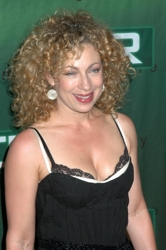 Some natural curly people don't embrace their natural texture. As a result, they desire to combine a blow dryer and some styling tool to achieve either stick straight strands or soften curls into loose waves. Either goal generally requites the use of a brush.
Some natural curly people don't embrace their natural texture. As a result, they desire to combine a blow dryer and some styling tool to achieve either stick straight strands or soften curls into loose waves. Either goal generally requites the use of a brush.
For most people a brush used to style natural texture into straight strands or looser waves should be wide and 100% boar bristle. The wider the brush, the straighter the strands will dry.
When a brush is utilized, the hair should be first towel blotted to remove excess wetness and should only be damp. This means less overall damage than when the brush is applied to soaking wet strands.
Known Dangers Of Brushing Either Wet Or Dry Textured Tresses
One common result of detangling waves, curls, coils and similar textures is that the brush bristles may get caught up in the tangles and ultimate cause breakage. Have you ever heard of someone getting a brush caught in their tresses? Yes, it's happened to me and my hair is not nearly as thick, wavy or curly as some.
 The danger of getting a brush caught in my own hair is why I resist using my Mason Pearson until I have already detangled the majority of my hair with my fingers. Even then, I work in very small sections, starting at the very ends and working very slowly up the hair shaft.
The danger of getting a brush caught in my own hair is why I resist using my Mason Pearson until I have already detangled the majority of my hair with my fingers. Even then, I work in very small sections, starting at the very ends and working very slowly up the hair shaft.
If the hair is bone dry, you may want to apply a small amount of your favorite hair oil before you detangle with your fingers. It does help add back moisture and minimize potential ripping or breakage.
Brushes should ultimately only be used on previously detangle hair to smooth or just to spot detangle when all else fails.
Are The Rules Of Brushing The Same For All Hair Types?
Some hair types are more prone to ripping, breaking, tearing and frizzing than others. When the hair is fine it can be more delicate and thus much easier to damage. This is true with brushing wet or dry hair or even using a comb.
Other hair types are more forgiving and less likely to frizz, rip or tear. Ultimately if you truly understand your hair type and how fragile it is you can determine the very best way to detangle with the least amount of damage.
When In Doubt Reach For The Oils, Leave-in Conditioners, Deep Conditioning Treatments
 One secret method of keeping hair from breakage and damage is keeping hair properly conditioned by doing the appropriate conditioning. Ongoing conditioning treatments strengthen the entire structure of the hair and gives hair staying power. It makes hair less likely to rip, split or break in the long term.
One secret method of keeping hair from breakage and damage is keeping hair properly conditioned by doing the appropriate conditioning. Ongoing conditioning treatments strengthen the entire structure of the hair and gives hair staying power. It makes hair less likely to rip, split or break in the long term.
(Image of Amy Brenneman - DC Media - All Rights Reserved)
Detangling Wavy, Curly, Textured Hair In Shower
Follow the steps below to detangle in the shower:
1. Cleanse hair with desired products and methods ranging from water only (WO) to conditioner only (CO)
3. Gently squeeze your tresses to remove excess water
5. Working with small sections from the ends to the roots, use fingers to detangle.
7. When strands are completely detangled rinse with lukewarm water leaving a light layer of conditioner on the hair.
 9. Towel blot to remove excess water.
9. Towel blot to remove excess water.
11. Apply a leave-in conditioner and/or defristant product to completely block frizz.
Avoid utilizing styling products containing alcohol or any types of styling products which may weigh the hair down. Use a hair-dryer only when absolutely necessary since the heat will zap curly hair of moisture. Moisture robbed hair is the fastest way for hair to frizz.
Summary
The general rule of thumb is to never brush wet, damp or dry curly hair because it is prone to be naturally dry and fragile and can easily be damaged. The best way to detangle naturally textured hair is to do so in the shower with a generous amount of conditioner and your fingers.
If the fingers are not a workable option, a wide toothed comb or pick with smooth teeth is the next best bet.
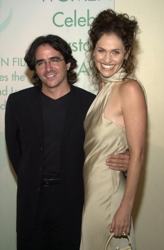 When hair is completely dry the fingers again are the best detangling tool although a smooth pick dispatched on pre-oiled tresses can be a safe method to follow.
When hair is completely dry the fingers again are the best detangling tool although a smooth pick dispatched on pre-oiled tresses can be a safe method to follow.
More Information
Please follow me on Twitter at: http://Twitter.com/HairBoutique. I look forward to meeting new people from all walks of Twitter and learning from their Tweets. Visit us at Hairboutique.com located at: http://www.HairBoutique.com, on Facebook, MySpace and YouTube.
Thank you for visiting us at The HairBoutique Blog and for leaving your comments. They are very much appreciated. We apologize in advance but must remove any direct advertisements or solicitations.
Social Media Network Information
Please follow us on Twitter at: https://Twitter.com/HairBoutique. I look forward to meeting new people from all walks of Twitter and learning from their Tweets.




